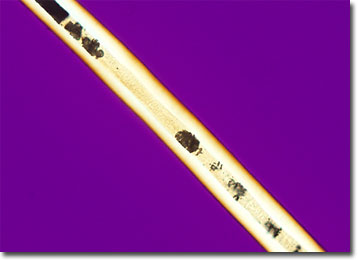Polarized Light Microscopy Digital Image Gallery
Alpaca Natural Charcoal Wool
Alpacas are members of the camel family, Camelidae, which inhabit South America and have been domesticated for thousands of years. Though the hoofed mammals are sometimes slaughtered for their meat, they are predominantly utilized for wool production.

Closely related to the vicuña, llama, and guanaco, the alpaca is often grouped with these other animals under the collective term lamoids, which is meant to distinguish them from the Old World camelids. Unlike true camels, lamoids do not feature humps on their backs, although they are otherwise quite similar in appearance. Both camels and lamoids are believed to have originated in North America, but over the course of history have come to inhabit completely different areas of the Earth. Today, the natural range of alpacas is restricted to only parts of Bolivia, Chile, and Peru, but the animals are appearing with increasing frequency in the United States, Canada, and several other countries where breeders have taken an interest in raising them, primarily as source of wool.
The coat of the alpaca is typically shaggy and lustrous, but varies significantly in color, sometimes appearing a light tan, yellow, or even white, while at other times exhibiting much darker hues of brown, charcoal gray, or black. When sheared for human use, the wool can also be readily dyed into an even greater array of colors. This fact, along with the material’s negligible weight, resistance to damage from the weather, and excellent insulating capabilities, ensures that alpaca wool finds frequent use in a variety of items, including coats, sleeping bags, and blankets. When combined with other fibers, alpaca wool is sometimes utilized in suit and dress fabrics as well.
